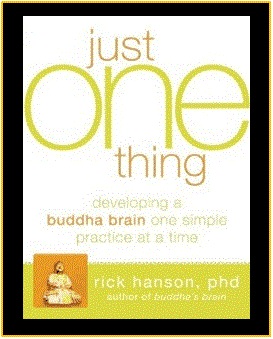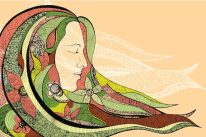Update: The winners for this giveaway have already been chosen. Subscribe to Tiny Buddha for free daily or weekly emails and to learn about future giveaways!
The Winners:
I read a lot of books about mindfulness; this was by far one of my favorites. In his book Just One Thing: Developing a Buddha Brain One Simple Practice at a Time, Rick Hanson offers practical, daily practices, backed by the latest in brain research, to help us avoid stress, improve our mood, enjoy life more fully, and develop emotional resilience.
This is not merely a book of mindfulness exercises; it’s a guide that helps us rewire our brains for increased happiness and overall well-being. I highly recommend Just One Thing to anyone who’s felt overwhelmed by disempowering, negative thoughts.
The Giveaway
To enter to win 1 of 2 free copies of Just One Thing:
- Leave a comment below.
- Tweet: RT @tinybuddha Book Giveaway & Interview with Rick Hanson: Develop a Buddha Brain http://bit.ly/rW3u3N
If you don’t have a Twitter account, you can still enter by completing the first step. You can enter until midnight PST on Sunday, December 11th.
The Interview
1. Your work is based on the idea that meditation and mindfulness can change the brain. Can you expand on this?
Actually, I’d put this a little more broadly: my work—and that of many other scholars and clinicians—is grounded in the general fact of “experience-dependent neuroplasticity,” which is the capacity of mental activity to change neural structure.
For example, researchers studied cab drivers who must memorize London’s spaghetti snarl of streets, and at the end of their training their hippocampus—a part of the brain that makes visual-spatial memories—had become thicker: much like exercise, they worked a particular “muscle” in their brain, which built new connections among its neurons.
Similarly, another study found that long-term mindfulness meditators had thicker cortex in parts of the brain that control attention and tune into one’s body.
In the saying from the work of the Canadian psychologist, Donald Hebb: “neurons that fire together, wire together.”
Fleeting thoughts and feelings leave lasting traces in neural structure. Whatever we stimulate in the brain tends to grow stronger over time.
A traditional saying is that the mind takes the shape it rests upon. The modern update would be that the brain takes its shape from whatever the mind rests upon—for better or worse. The brain is continually changing its structure. The only questions are: Who is doing the changing: oneself or other forces? And are these changes for the better?
In this larger context, my focus is on how to apply these new scientific findings: how to use the mind to change the brain to change the mind for the better—for psychological healing, personal growth, and (if it’s of interest) deepening spiritual practice. I’m especially interested in:
• How the brain has been shaped by evolution, giving us problematic tendencies toward greed, hatred, heartache, and delusion (using traditional terms) as well as wonderful capacities for happiness, peace, love, and wisdom. For example, we have a brain that makes us very vulnerable to feeling anxious, helpless, possessive, fixated on short-term rewards, angry, and aggressive. These qualities helped our ancestors survive and pass on their genes, but today they lead to much unnecessary suffering and conflict on both personal and global scales.
• “Neurologizing” the deep Buddhist analysis of the mind: what is going on inside the brain when a person is caught in the craving that leads to suffering? Alternately, what is happening in the brain when a person is experiencing equanimity, lovingkindness, meditative absorption, or liberating insight?
• Using neurologically-informed methods to help overcome our ancient inclinations to fear, dehumanize, exploit, and attack “them” so that 7 billion of us can live in peace with each other on our fragile planet.
In sum, this brain stuff can sound exotic or esoteric, but in essence the approach is simple: find the neural processes that underlie negative mental factors, and reduce them; meanwhile, find the neural processes that underlie positive mental factors, and increase them. Less bad and more good—based on neuroscience and Western psychology, and informed by contemplative wisdom.
Of course, much is not yet known about the brain, so this approach is necessarily an exploration. But if we remain modest about what we don’t know, there are still many plausible connections between the mind and the brain, and many opportunities for skillful intervention for ourselves, for our children and others we care for, and for humankind as a whole.
2. Can anyone develop a “buddha brain,” even people struggling with mental illness or depression?
Definitely!
First, a “buddha brain” is simply one that knows how to be truly happy in the face of life’s inescapable ups and downs. (I don’t capitalize the word “buddha” here to focus on the original nature of the word—which is “to know, to see clearly”—to distinguish my general meaning from the specific historical individual known as The Buddha.)
The possibility of this kind of brain is inherent in the human brain that we all share; any human brain can become a buddha brain. Therefore, a buddha brain is for everyone, whatever their religious orientation (including none at all).
Second, we all must begin the path wherever we are—whether that’s everyday stress and frustration, mental illness, anxiety, sorrow and loss, or depression. In any moment when we step back from our experience and hold it in mindful awareness, or when we begin to let go of negative feelings and factors, or when we gradually turn toward and cultivate positive feelings and factors…then we are taking a step toward developing a buddha brain.
Each small step matters. It was usually lots of small steps that took a person to a bad place, and it will be lots of small steps that take him or her to a better one.
Third, mental anguish or dysfunction can help us grow. They teach us a lot about how the mind works, they can deepen compassion for the troubles and sorrows of others, and, frankly, they can be very motivating.
Personally, the times in my life when I have been most intent on taking my own steps toward a buddha brain have been either when I was really feeling blue—and needed to figure out how to get out of the hole I was in—or when I was feeling really good, and could still sense that there had to be more to life than this, and more profound possibilities for awakening.
3. I recently quoted you in a short post about negativity bias. You wrote, “The brain is like Velcro for negative experiences and Teflon for positives ones.” Can you explain this in more detail?
As the brain evolved, it was critically important to learn from negative experiences—if one survived them! “Once burned, twice shy.” So the brain has specialized circuits that register negative experiences immediately in emotional memory.
On the other hand, positive experiences—unless they are very novel or intense—have standard issue memory systems, and these require that something be held in awareness for many seconds in a row to transfer from short-term memory buffers to long-term storage.
Since we rarely do this, most positive experiences flow through the brain like water through a sieve, while negative ones are caught every time. Thus my metaphor of Velcro and Teflon—an example of what scientists call the “negativity bias” of the brain.
The effects include: a growing sensitivity to stress, upset, and other negative experiences; a tendency toward pessimism, regret, and resentment; and a long shadows cast by old pain.
4. What is one practice we can adopt in our everyday lives to overcome our negativity bias?
Several times a day, take in the good by really savoring a positive experience for 10-20 seconds or more. (For free, you can see lots more about this method at my website, www.RickHanson.net, and the second chapter of Just One Thing is about this.)
Over time, much as repeated negative experiences make the brain more sensitive to them, I believe that repeatedly savoring positive experiences can train your brain to internalize them increasingly rapidly—in effect, making your brain like Velcro for the positive and Teflon for the negative.
5. What is one of the most effective practices for instant stress relief?
How about not one, but three:
• Activate the parasympathetic wing of your nervous system by taking several long exhalations, at least twice as long as your inhalation.
•Notice that you are actually basically alright right now. Not perfect, but basically OK.
• Bring to mind the felt sense of being with someone who loves you.
6. You say that the brain has powerful, natural capacities toward intimacy. What, then, do you believe causes some of us to isolate ourselves or feel alone?
Many reasons. Sometimes the longing for closeness led to pain in the past, or we saw this happen to others, or we simply worried that it could happen to us.
The trick now is to risk the dreaded experiences related to intimacy in thoughtful, appropriate ways that are likely to succeed. Then, when things go well (as they usually do), really take in the good of this experience, to help your brain gradually learn that it is OK to get closer to others.
7. You’ve said that love and compassion can combat anxiety. How do they do that—and how can we access those feelings more readily, particularly when we feel threatened?
“Off-line,” when you do not feel threatened, deepen the sense of feeling connected by routinely taking in experiences of feeling cared about. Then, at times you do feel threatened or anxious, call up the body sense of feeling cared about. Stay strong with this, being a good friend to yourself, helping your mind stay focused on the sense of having allies, being part of a group, feeling included, liked, and loved.
8. If someone was to adopt just one of daily practice to foster a buddha brain which would you recommend?
Taking in the good. I’ve been doing practices for 35 years (I’ve had a lot to practice with!), and this is my all-time favorite practice. I use it every day.
Learn more about Just One Thing: Developing a Buddha Brain One Simple Practice at a Time on Amazon.
FTC Disclosure: I receive complimentary books for reviews and interviews on tinybuddha.com, but I am not compensated for writing or obligated to write anything specific. I am an Amazon affiliate, meaning I earn a percentage of all books purchased through the links I provide on this site.
About Lori Deschene
Lori Deschene is the founder of Tiny Buddha. She started the site after struggling with depression, bulimia, c-PTSD, and toxic shame so she could recycle her former pain into something useful and inspire others to do the same. You can find her books, including Tiny Buddha’s Gratitude Journal and Tiny Buddha’s Worry Journal, here and learn more about her eCourse, Recreate Your Life Story, if you’re ready to transform your life and become the person you want to be.
- Web |
- More Posts













 Though I run this site, it is not mine. It's ours. It's not about me. It's about us. Your stories and your wisdom are just as meaningful as mine.
Though I run this site, it is not mine. It's ours. It's not about me. It's about us. Your stories and your wisdom are just as meaningful as mine. 